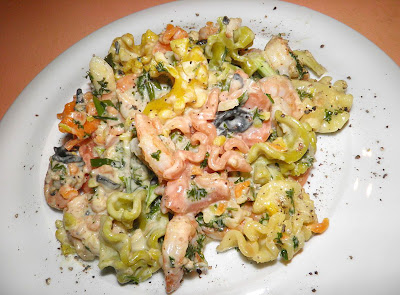A house is not a home unless it contains food and fire for the mind as well as the body. – Benjamin Franklin
 |
| Delicious Indian spices in a yogurt-based2 marinade/sauce. |
 |
| I only did 1/2 of the chicken cited in the recipe. It was just enough for two. |
“Farch,” in case you don’t know, is that long, interminably miserable two months—February and March—when we all want nothing more desperately than for Spring to arrive. I first heard the term used by Jim Meek, a contributor to our local provincial paper, several years ago. I love the word. It’s ugly, just like the last two months of winter.
Now it is officially Spring, I know. It just doesn’t feel like it here. Last night was about -6°C, and tonight we may hit -10°C. We even had some serious snow squalls yesterday. I’ve had enough. I want to be outside.
Unfortunately I didn’t have the ability to do this outside so I had to broil it, but the principle is the same. Just skewer the chicken and do it on “the barbie.”
The flavours of chicken marinated in Indian spices sometimes just hits the spot. It smells great cooking and tastes great too. The spice quantities may seem like a lot but remember it’s a marinade, so most of it gets left behind when the chicken is being cooked.
A short rant about dandelion greens
The other part of this recipe is a twist on a traditional Indian “saag” (cooked spinach). What’s more Spring-like than dandelion greens? If you’ve never had dandelion greens you should buck up and be brave. They’re actually really good.
 |
| To broil, space the chicken (and all the marinade) evenly on a foil-lined baking sheet. Grilling would be fantastic. |
I find the greens from the store a little bitter. Think of the bitterness of rapini as opposed to broccoli. Our local dandelions I think are “peppery” as opposed to bitter. Quite pleasant actually.
I would suggest using local dandelion greens that you pick yourself. They’re plentiful enough since dandelions are weeds. Just make sure, as you always should, that you harvest from an unpolluted area – and wash them before use. If you have the fortune to live with pets you’ll know why…
By the way, dandelion greens are full of nutrients, so why not use something that is both tasty and free? Some benefits are: antiviral properties; help stabilizing blood sugar; digestive aid; positive effects on cholesterol, and kidney function. So you see there's a lot of reasons to include this oft-times troublesome plant in your diet.
Last Spring we had smoked mackerel with a dandelion green salad dressed with a simple vinaigrette. That was all. It was an amazing meal.
But now back to the recipes at hand…
 |
| Remember to turn the chicken half-way through the cooking time to brown both sides. |
Prep: 10 min | Marinate: 1 hour | Cook: 8 min | Serves 4
1-1/2 lb chicken breast, cubed
1/2 cup yogurt
3 green finger chillies, chopped
1 tsp ground cumin
1 tsp ground cardamom
1 tsp ground cinnamon
1 tsp ground coriander
2 tbsp chopped fresh ginger
2 garlic cloves, chopped
1/2 tsp salt
1/4 cup chopped cilantro
Mix all the ingredients together except for the chicken in a shallow dish. Cube the chicken and toss well with the marinade. Cover with plastic wrap and let marinate for 1 hour on the counter, or longer (a whole day if you wish) in the refrigerator.
Two methods to cook:
1. Arrange the chicken on foil on a baking sheet. Broil for 3-4 minutes per side, depending on your cube size, or
2. Skewer the chicken and barbecue on each side for a few minutes until browned. You could alternate the chicken pieces with tomatoes or another quick-cooking vegetable if you wished.
 |
| Dandelion greens are really good for you, and they're free for large parts of the year. What's not to love? |
Time: 10 min
1 bunch dandelion greens
1 tbsp butter or ghee
1 onion, chopped
3 garlic cloves
1 tbsp fresh ginger, chopped
1/2 cup water
2 tsp Garam masala
1 tsp ground cumin
2 green finger chillies, chopped
salt and pepper, to taste
1/4 cup yogurt
Sauté the onions, garlic, ginger and chillies in the butter until fragrant. Add the water and dandelion greens and cover.
Let the greens wilt for 5 minutes, then roughly purée the mixture with a stick blender in the pot. Add the Garam masala, cumin, salt, pepper and yogurt. Reheat and serve.
………………………………….
If you like this post retweet it using the link at top right, or share it using any of the links below.
Questions? Comments? Derogatory remarks?






























